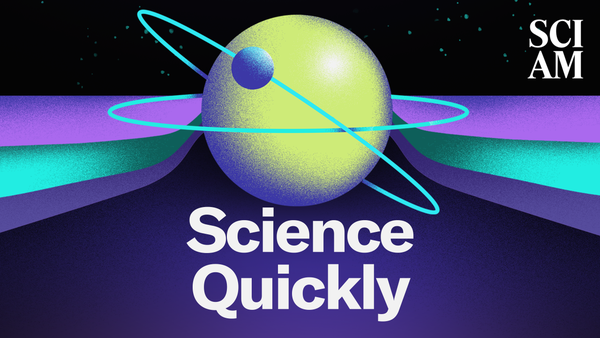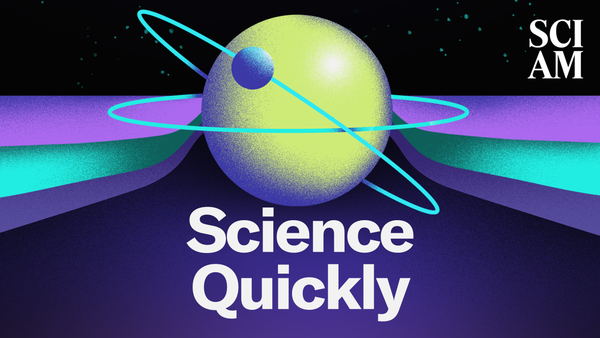Your Penis Might Be Full of Microplastics And The Seine is Definitely Full of Bacteria
Microplastics are everywhere, the Seine’s Olympic ambitions are complicated by poop, and the Starliner spacecraft delays its return to Earth.

Anaissa Ruiz Tejada/Scientific American
Rachel Feltman: Happy Monday, listeners. For Science Quickly, this is Rachel Feltman, here to give you your weekly news roundup. I hope you’re staying cool if it’s finally summer wherever you’re listening from. But, if you need a little help with that, you’ll definitely want to tune in again on Wednesday. But for now let’s kick off the week by diving into some of the stories you may have missed.
Last Wednesday scientists published a small study with some big implications. They reported finding microplastics in four out of the five penis tissue samples that they studied. And yeah, five is a pretty small sample size, like I said this was a tiny study. This comes just a few weeks after a different study found microplastics in all 23 human testicles and 47 dog testicles tested.
In both cases researchers sounded the alarm on a potential link between microplastics and sexual health concerns. While neither study showed a causal link, the research on penis tissue specifically looked at men who came to the hospital for a surgery to treat erectile dysfunction. And in the study from back in May, researchers noted that dogs with higher concentrations of certain microplastics had lower sperm counts. Some recent studies have suggested that human sperm quality is on the decline, though others have reported mixed results or even a general increase in sperm quality. Experts say that’s a really tricky thing to pin down at the population level, and the dropping fertility rate could just as easily be blamed on people choosing to have fewer kids or to start trying for them later in life. But just because we’re not sure that sperm quality is falling doesn’t mean it’s no big deal to find microplastics in our reproductive organs.
On supporting science journalism
If you’re enjoying this article, consider supporting our award-winning journalism by subscribing. By purchasing a subscription you are helping to ensure the future of impactful stories about the discoveries and ideas shaping our world today.
Microplastics are tiny particles of—you guessed it—plastic. Some are made purposefully small—remember those chunky little beads that were in so many exfoliating face washes back in the day? And others come about because plastic can take decades or even centuries to decompose, and even then it doesn’t fully go away; it just breaks down into smaller and smaller pieces. Given that humans produce about 400 million metric tons of plastic waste each year, it’s not surprising that these bits and bobs show up in lots of places. But it’s recently become apparent that they show up everywhere: microplastics have turned up in Antarctic snow, in the clouds above Mount Fuji, inside deep-sea creatures and near the top of Mount Everest.
Microplastics have also been found in lots of human tissues, including blood and breast milk. While we’re still not sure exactly how these particles impact us, the preliminary research isn’t reassuring. One recent study looked at plaques that had been surgically removed from the carotid arteries of 304 people and found microplastics in roughly half of them. In a 34-month follow-up, patients with the microplastics in their plaques had a 4.5 times higher rate of heart attack, stroke and death. Another study found a correlation between microplastics in feces and inflammatory bowel disease.
It’s clear we’ve got to tackle this problem, and I’m starting to suspect that future humans will talk about plastic takeout containers the same way we talk about folks wearing lead face paint. Governments are taking action, but it’s slow going. For instance, California enacted ambitious legislation that aims to cut plastic packaging in the state by 25 percent over the course of 10 years.
So what can you do right now—other than calling your elected officials and telling them you don’t actually want microplastics in your penis? Researchers think that avoiding plastic food and beverage packaging can go a long way. You should also definitely stop microwaving food in plastic. It may not protect you from all the microplastic in the world, but it should at least lower the amount of plastic you personally have in your poop.
Speaking of poop: with the Summer Olympics quickly approaching, new test results revealed that the Seine River contained unsafe levels of E. coli and other microbes in early June. The report, published by the monitoring group Eau de Paris, came out the day after an International Olympic Committee executive claimed there were “no reasons to doubt” that marathon and triathlon swimmers could race in the river. We’re working on a more in-depth story about efforts to clean up the Seine in time for the games, so keep an eye out for that episode in your feed next month.
[CLIP: Diving splash]
Remember Boeing’s Starliner spacecraft? That’s the one that had a delayed launch because of a helium leak and a rocket issue. While it did finally make its way to the International Space Station earlier this month, the journey wasn’t exactly smooth sailing.
The craft safely carried veteran NASA astronauts Butch Wilmore and Suni Williams to the ISS, but it has experienced four more helium leaks and five failures among its 28 maneuvering thrusters since heading to space
Now Boeing and NASA officials have announced that the astronauts’ visit, which was supposed to last about a week, is getting stretched a little longer, with their earliest possible return date set for Wednesday.
NASA reps have said they expect the vehicle to get the two astronauts back home safely, but they want to take their time studying the problems while they can. The issues happened in Starliner’s service module, which is going to be jettisoned as the spacecraft returns to Earth.
We’ll wrap up with a study from last week that jumped out at me as being kind of—hopeful?
Last Thursday researchers shared their findings on how the rhesus macaques of Cayo Santiago, also known as Monkey Island, fared in the wake of Hurricane Maria.
In addition to killing about 3,000 people throughout Puerto Rico, the storm destroyed 63 percent of the vegetation on Cayo Santiago. Tree cover remains scarce even now, which poses a problem for local macaques searching for protection from the hot sun. But researchers say that while the storm’s damage does seem to have radically altered how the monkeys live, those changes aren’t necessarily bad.
The study’s authors say macaques are generally thought of as aggressive, competitive animals. But in the time since Hurricane Maria, the researchers’ data shows, the monkeys willing to cooperate and share space in the shade have been more likely to survive. Researchers are now seeing more social behavior from the population even beyond the moments when the monkeys are crowded together for shade. It sure sounds like we could learn a thing or two from these distant cousins of ours! The world needs more monkey business.
That’s all for this week’s science news roundup. Tune in on Wednesday to learn how to handle the ever increasing heat of summer. And don’t forget to join us on Friday for the latest episode of our ongoing audio adventure in Antarctica.
Before you go, we’d love to hear your thoughts on the show: How do you like the new episode formats? Do you have any stories or subjects you’d like us to investigate? Get in touch with us at ScienceQuickly@sciam.com. You can also let us know how you’re liking the show with a rating or review! We really appreciate your feedback.
Science Quickly is produced by me, Rachel Feltman, along with Fonda Mwangi, Kelso Harper, Carin Leong, Madison Goldberg and Jeff DelViscio. Elah Feder, Alexa Lim, Madison Goldberg and Anaissa Ruiz Tejada edit our show, with fact-checking from Shayna Posses and Aaron Shattuck. Our theme music was composed by Dominic Smith. Subscribe to Scientific American for more up-to-date and in-depth science news.
For Science Quickly, I’m Rachel Feltman. Have a great week!

